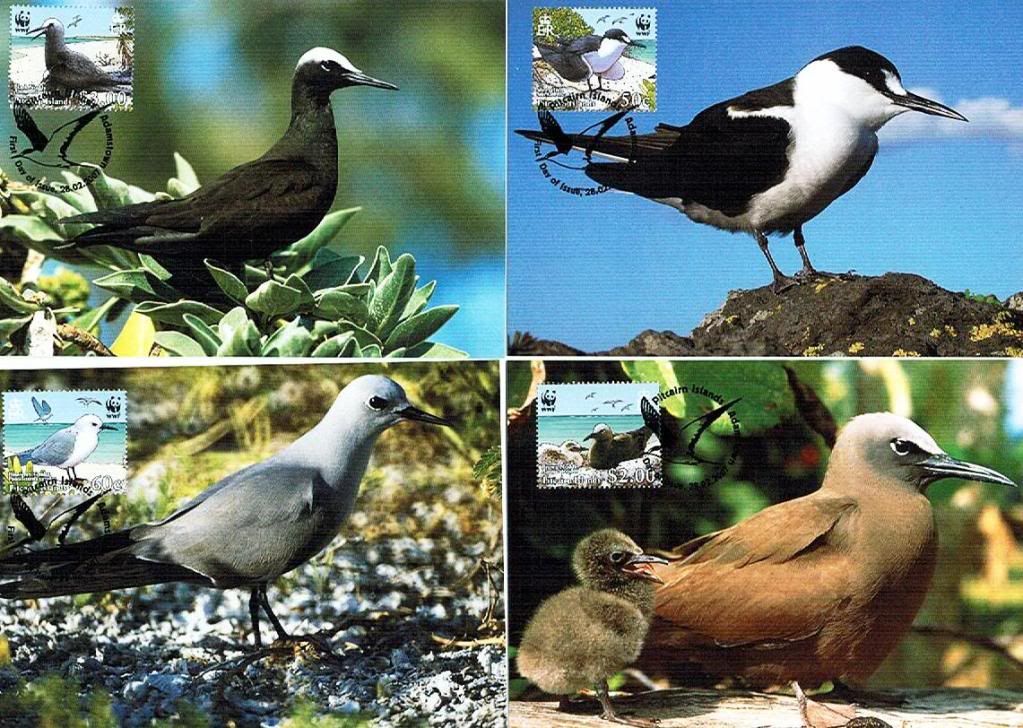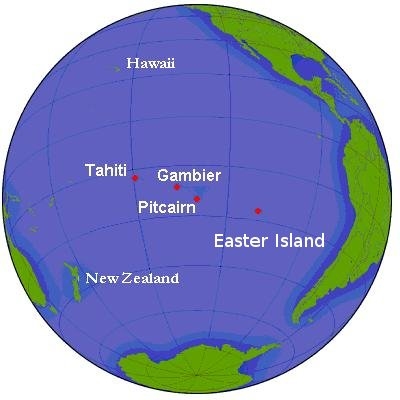UL (Upper-left): "The Black Noddy or White-capped Noddy (Anous minutus) is a seabird from the tern family. It resembles the closely-related Brown or Common Noddy (A. stolidus), but is smaller with darker plumage, a whiter cap, a longer, straighter beak and shorter tail. It was long - and sometimes still is - included within the Brown Noddy.
"The Black Noddy has a worldwide distribution in tropical and subtropical seas, with colonies widespread in the Pacific Ocean and more scattered across the Caribbean, central Atlanticand in the northeast Indian Ocean. At sea it is usually seen close to its breeding colonies within 80 km of shore. Birds return to colonies, or other islands, in order to roost at night."
UR: "The Sooty Tern, Onychoprion fuscatus (formerly Sterna fuscata[1]), is a seabird of the tern family(Sternidae). It is a bird of the tropical oceans, breeding on islands throughout the equatorial zone. Colloquially, it is known as the Wideawake Tern or just wideawake. This refers to the incessant calls produced by a colony of these birds, as does the Hawaiian name ʻewa ʻewa which roughly means "cacophony".[2] In most of Polynesia its name is manutara or similar however – literally "tern-bird",[3] though it might be better rendered in English as "the tern" or "common tern". This refers to the fact that wherever Polynesian seafarers went on their long voyages, they would find these birds, and usually in astounding numbers."
LL: "The Grey Noddy or Grey Ternlet (Procelsterna albivitta) is a seabird belonging to the tern family Sternidae. It was once regarded as a pale morph of the Blue Noddy (Procelsterna cerulea) but is now often considered to be a separate species."
"It feeds in shallow water, not moving far from the breeding colonies. It gathers in large feeding flocks which can contain thousands of individuals. They feed by hovering over the water and dropping down to pick food from the surface. Plankton forms the bulk of the diet and small fish are also eaten.
Breeding takes place in colonies on rocky islands. The nest site is a sheltered rocky surface or underneath a boulder or clump of vegetation. A single egg is laid. It is whitish with dark markings and is incubated by both parents for about 32 days. The young birds are fed on regurgitated food and fledge after around 35 days."
The largest of the noddies, it can be told from the closely related Black Noddy by its larger size and plumage, which is dark brown rather than black.
The Brown Noddy is a tropical seabird with a worldwide distribution, ranging from Hawaii to the Tuamotu Archipelago and Australia in the Pacific Ocean, from the Red Sea to the Seychelles and Australia in the Indian Ocean and in the Caribbean to Tristan da Cunha in the Atlantic Ocean.
The Brown Noddy is colonial, usually nesting on the in elevated situations on cliffs or in short trees or shrubs.
It only occasionally nests on the ground.
A single egg is laid by the female of a pair each breeding season.
Etymology: Anous is Greek for "unmindful" (Harrison, 1990; see also nous), and stolidus means "impassive" in Latin (see also stolid).
The birds are often unwary and find safety in enormous numbers.
To sailors, they were well known for their apparent indifference to hunters or predators."
=========
"The Pitcairn Islands ( /ˈpɪtkɛərn/;[1] Pitkern: Pitkern Ailen), officially named the Pitcairn, Henderson, Ducie and Oeno Islands, form a group of four volcanic islands in the southern Pacific Ocean.
/ˈpɪtkɛərn/;[1] Pitkern: Pitkern Ailen), officially named the Pitcairn, Henderson, Ducie and Oeno Islands, form a group of four volcanic islands in the southern Pacific Ocean.
| Pitcairn, Henderson, Ducie and Oeno Islands Pitkern Ailen | ||||||
|---|---|---|---|---|---|---|
| ||||||
St. Pauls Point, Pitcairn Island
"The Landing", Pitcairn Island
"The Pitcairn Islands (
The islands are a British Overseas Territory (formerly a British colony), the last remaining in the Pacific.[2]
The four islands – named Pitcairn, Henderson, Ducie, and Oeno – are spread over several hundred miles of ocean and have a total area of about 18 square miles (47 km2).
Only Pitcairn, the second largest and measuring about 2 miles (3.2 km) across, is inhabited.
The islands are best known as home of the descendants of the Bounty mutineers and the Tahitians (or Polynesians) who accompanied them, an event retold in numerous books and films.
This history is still apparent in the surnames of many of the islanders.
With only about 50 inhabitants[3] (from four families as of 2010: Christian, Warren, Young, and Brown), Pitcairn is the least populous jurisdiction in the world (although it is not a sovereign nation).
The United Nations Committee on Decolonisation includes the Pitcairn Islands on the United Nations list of Non-Self-Governing Territories.[4]"
Please read: http://en.wikipedia.org/wiki/Pitcairn_islands
=================
Happy PFF (Postcard Friendship Friday)!
Please visit: http://thebestheartsarecrunchy.blogspot.com/ (wait until Beth posts the today's Linky tool for the meme, then make your entry, if you want to join).







